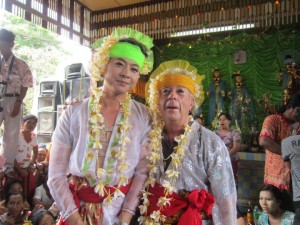IN AUGUST, 2010, I traveled from my home in Bangkok to Mandalay, finally to visit the Taungbyon Nat Pwe. Stories have circulated about this “gay” event, but nothing very coherent was available.
Myanmar or Burma, as it used to be known (and still is in some quarters) is a predominantly Buddhist country. The largest ethnic group, the Bamar (whence the name “Burma”), occupies the central areas of the country around the old royal capital of Mandalay, and south to Yangon and the delta. The first Burmese kingdom was founded in Bagan in this central region, by King Anawratha, who reigned from 1044 to 1077.
 Anawratha was a convert to the Theravada branch of Buddhism and made it the national religion. But the worship of local spirits, called Nats, could not be eliminated. So Anawratha institutionalized Nat worship but made it subordinate to Buddhism. On the grounds of his beautiful Shwezigon Paya (stupa) in Bagan, Anawratha installed a pavilion to the 37 Lords. Each, it is said, was a powerful person who died tragically. Their tragic deaths excluded them from the cycle of rebirth, with the result that their spirits are still present, for good or for evil. They need to be propitiated, and they can be invoked. Today, most Buddhist temples in Myanmar have a Nat shrine within the temple complex.
Anawratha was a convert to the Theravada branch of Buddhism and made it the national religion. But the worship of local spirits, called Nats, could not be eliminated. So Anawratha institutionalized Nat worship but made it subordinate to Buddhism. On the grounds of his beautiful Shwezigon Paya (stupa) in Bagan, Anawratha installed a pavilion to the 37 Lords. Each, it is said, was a powerful person who died tragically. Their tragic deaths excluded them from the cycle of rebirth, with the result that their spirits are still present, for good or for evil. They need to be propitiated, and they can be invoked. Today, most Buddhist temples in Myanmar have a Nat shrine within the temple complex.





